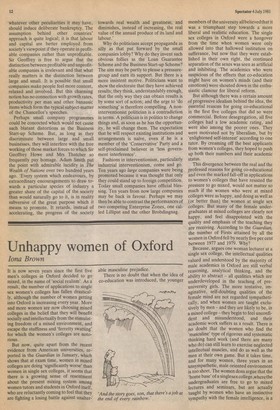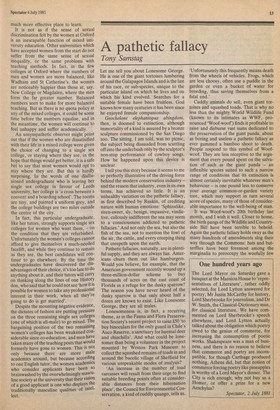Unhappy women of Oxford
Iona Brown
It is now seven years since the first five men's colleges in Oxford decided to go mixed, in the name of 'social realism'. As a result, the number of applications to single sex women's colleges has fallen drastically, although the number of women getting into Oxford is increasing every year. More and more women are now choosing mixed colleges in the belief that they will benefit socially and intellectually from the stimulating freedom of a mixed environment, and escape the stuffiness and lerretty swatting' for which the women's colleges are notorious.
But now, quite apart from the recent evidence from American universities, reported in the Guardian in January, which shows that at exam time, women in mixed colleges are doing 'significantly worse' than women in single sex colleges, it seems that there is a growing sense of resentment about the present mixing system among women tutors and students in Oxford itself, who are reluctantly coming to feel that they are fighting a losing battle against unalter; members of the university all believed that it was a triumphant step towards a more liberal and realistic education. The single sex colleges in Oxford were a hangover from the time when women were only allowed into that hallowed institution on sufferance, but now that they were established in their own right, the continued separation of the sexes was seen as artificial and inhibiting. The academics who were suspicious of the effects that co-education might have on women's minds (and their emotions) were shouted down in the enthusiastic clamour for liberal reform.
But although there was a certain amount of progressive idealism behind the idea, the essential reasons for going co-educational in the first five colleges that did so were commercial. Before desegregation, all five colleges had a low academic rating, and were also among the poorer ones. They were motivated not by liberalism, but by 'enlightened self-interest' according to one tutor. By creaming off the best applicants from women's colleges, they hoped to push up both their numbers and their academic status.
This divergence between the real and the professed reasons for going co-educational and even the marked fall-off in applications to women's colleges that have resisted the pressure to go mixed, would not matter so much if the women who were at mixed colleges were as happy, and doing as well as (or better than) the women at single sex colleges. But many of the female undergraduates at mixed colleges are clearly not happy, and feel disappointed with the quality and emphasis of the teaching they are receiving. According to the Guardian, the number of Firsts attained by all the women in Oxford fell by nearly five per cent between 1977 and 1979. Why?
Because, argues one woman lecturer at a single sex college, the intellectual qualities valued and understood by the majority of male academics in Oxford are still verbal reasoning, analytical thinking, and the ability to abstract — all qualities which are underdeveloped in the teaching of preuniversity girls. The more tentative, imaginative, self-doubting qualities of the female mind are not regarded sympathetically, and when women are taught exclusively by men — and they are likely to be, in a mixed college — they begin to feel unconfident and misunderstood, and their academic work suffers as a result. There is no doubt that the women who find the 'masculine' type of rigorous and systematic thinking hard work (and there are many who do) can still learn to exercise neglected intellectual muscles, and do as well as the men at their own game. But it takes time, and for many women, three years in an unsympathetic, male oriented environment is too short. The women dons argue that the 'home base' of a single sex college,wherethe undergraduates are free to go to mixed lectures and seminars, but are actually taught by women who have an instinctive sympathy with the female intelligence, is a much more effective place to learn.
It is not as if the sense of sexual discrimination felt by the women at Oxford is an inescapable function of mixed university education. Other universities which have accepted women from the start do not suffer from the same sense of sexual inequality, or the same problems with teaching methods. In fact, in the few colleges at Oxford where the numbers of men and women are more balanced, like Wadham and St Catherine's, the women are noticeably happier than those at, say, New College or Magdalen, where the men form the far greater number. Balanced numbers seen to make for more balanced teaching. But as there is no quota policy at any of the mixed colleges, it could be some time before the numbers equalise, and in the meantime, the women will continue to feel unhappy and suffer academically.
An unsympathetic observer might point out that if the women who are dissatisified with their life in a mixed college were given the choice of changing to a single sex college, or staying where they are, in the hope that things would get better, it is a safe bet to say that most women would opt to stay where they are. But this is hardly surprising. In the words of one disillusioned undergraduate who is leaving her single sex college in favour of Leeds university, her college is 'a cross between a convent and a boarding school'. The rooms are tiny, and painted a uniform grey, and the college buildings are two miles outside the centre of the city.
In fact, this particular undergraduate, like her tutors, strongly supports single sex colleges for women who want them, — on the condition that they are refurbished. Unfortunately the women's colleges cannot afford to give themselves a much-needed facelift, and while they continue to remain as they are, the best candidates will continue to go elsewhere. By the time the undergraduates have discovered the disadvantages of their choice, it's too late to do anything about it, and their tutors will carry on thinking along the lines of one History don, who said that he could not see 'how it is possible for women to take any professional interest in their work, when all they're going to do is get married'. Despite the mounting negative evidence, the dictates of fashion are putting pressure on the three remaining single sex colleges (one of which is all-male) to go mixed. The bargaining position of the two remaining women's colleges has been weakened considerable since co-education, and men have taken many of the teaching posts that would formerly have gone to women. This is not only because there are more male academics around, but because according to one English tutor, the women academics who consider applicants have been so brainwashed by the overwhelmingly masculine society at the university that their vision of a good applicant is one who displays the traditionally masculine qualities of intellect.







































 Previous page
Previous page